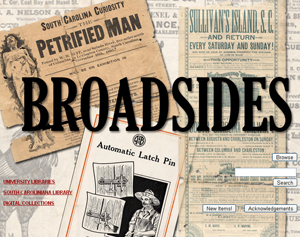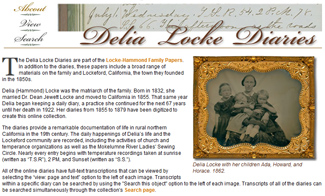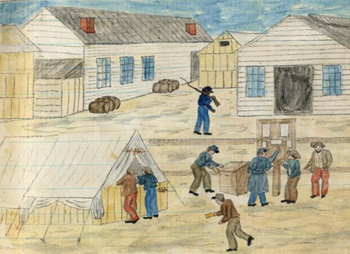 The Becker Collection is a great digital project from Boston College that contains over 600 drawings by Joseph Becker and others who worked for Frank Leslie’s Illustrated Weekly. The “Featured Images” slideshow provides a nice introduction to what is available in the collection. These drawings cover a range of Civil War related topics, such as camp life, military ceremonies and discipline, panoramas and landscapes, and ships. Other topics include the Chicago fire, political cartoons, and the Trans-Atlantic cable. Biographies of the artists featured in this collection are also available.
The Becker Collection is a great digital project from Boston College that contains over 600 drawings by Joseph Becker and others who worked for Frank Leslie’s Illustrated Weekly. The “Featured Images” slideshow provides a nice introduction to what is available in the collection. These drawings cover a range of Civil War related topics, such as camp life, military ceremonies and discipline, panoramas and landscapes, and ships. Other topics include the Chicago fire, political cartoons, and the Trans-Atlantic cable. Biographies of the artists featured in this collection are also available.
19
Mar
10
Becker Collection – Drawings of the American Civil War Era
Posted by sailerd Published in 19th Century (1840-1880), Images Themes: Battles & Soldiers17
Mar
10
Western History – Historic Images
Posted by sailerd Published in 19th Century (1840-1880), Images Themes: Battles & Soldiers, Settlers & Immigrants The Denver Public Library has a nice digital collection of images related to various topics in Western history. While not available to download for free, each set of images can still be viewed as a slideshow – these include “Railroads,” “On the Trail and Covered Wagon,” “Western Life,” and “Wild West Shows.” Other digital collections from the Denver Public Library are available here.
The Denver Public Library has a nice digital collection of images related to various topics in Western history. While not available to download for free, each set of images can still be viewed as a slideshow – these include “Railroads,” “On the Trail and Covered Wagon,” “Western Life,” and “Wild West Shows.” Other digital collections from the Denver Public Library are available here.
22
Feb
10
Broadsides Collection
Posted by sailerd Published in 19th Century (1840-1880), Images, Letters & Diaries Themes: Battles & SoldiersThe University of South Carolina has a nice digital collection of over two hundred broadsides from the Colonial Era to the present. One can find broadsides related to secession, the Civil War, and a number of other topics. Almost all of the broadsides in this collection were originally printed in South Carolina. Other digital collections are available through the South Carolina Digital Library.
12
Feb
10
Delia Locke Diaries (1855-1879)
Posted by sailerd Published in 19th Century (1840-1880), Images, Letters & Diaries Themes: Contests & Elections, Women & FamiliesWhen Delia Locke and her husband moved to northern California in 1855, she started a diary that she continued to write in until her death in 1922. Thanks to the University of the Pacific, her diary entries between 1855 and 1879 are available online. Locke not only recorded detailed observations about daily life, but she also commented on major political events. Abraham Lincoln’s victory in the 1860 election was “good news,” as Locke noted on November 16, 1860. Four years later she still supported Lincoln. Even though she could not vote, she had strong opinions about the candidates. While Lincoln “[was] the representative of freedom,” Locke believed that Democrat George McClellan represented “slavery” and led a political “party which [was] composed of traitors at heart.” The University of the Pacific also has other interesting digital projects to explore, including “John Muir Journals,” John Muir Photographs, and several collections related to Japanese-American Internment Camps.
10
Feb
10
John Omenhausser, Civil War Sketchbook (1864-1865)
Posted by sailerd Published in Civil War (1861-1865), Images Themes: Battles & SoldiersConfederate John Jacob Omenhausser, who was captured in 1864 and spent about a year at a Union prison camp in Maryland, filled a sketchbook with over sixty paintings of camp life. The University of Maryland does not have all of Omenhausser’s paintings, but this one is the largest. Omenhausser, who served with the 46th Virginia Infantry, moved to Richmond after the war and worked as a candy maker. He had two children and later died in 1877. The University of Maryland has a number of other interesting digital collections available, including the “Sterling Family Papers” – which I highlighted in a previous post.
8
Feb
10
HarpWeek Political Cartoons
Posted by Published in Antebellum (1840-1861), Images, Lesson Plans Themes: Contests & Elections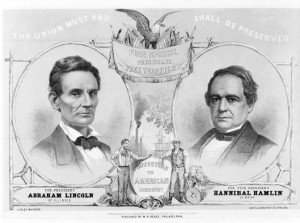 HarpWeek has an online collection of political cartoons from 14 presidential elections between the years 1860-1912. These cartoons provide a visual insight into the climate surrounding the Election of 1860, and its core issues. Some of the cartoons require a lot of prior historical knowledge, while others can be understood with some basic analysis. HarpWeek has convienently provided an analysis and explanation of each cartoon. There are other resources as well for the Election of 1860, including an overview of the historical context and a timeline of important events. Any of these political cartoons would be beneficial to a classroom discussion of this crucial election. This webpage provides a useful guide to using editorial cartoons in the classroom.
HarpWeek has an online collection of political cartoons from 14 presidential elections between the years 1860-1912. These cartoons provide a visual insight into the climate surrounding the Election of 1860, and its core issues. Some of the cartoons require a lot of prior historical knowledge, while others can be understood with some basic analysis. HarpWeek has convienently provided an analysis and explanation of each cartoon. There are other resources as well for the Election of 1860, including an overview of the historical context and a timeline of important events. Any of these political cartoons would be beneficial to a classroom discussion of this crucial election. This webpage provides a useful guide to using editorial cartoons in the classroom.
8
Feb
10
VMI Cadets & John Brown’s Execution – Dec. 1859
Posted by sailerd Published in Antebellum (1840-1861), Images, Letters & Diaries Themes: Slavery & Abolition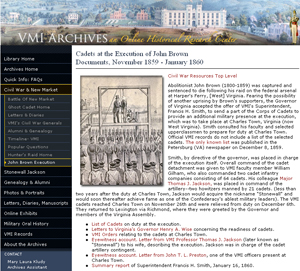 The Virginia Military Institute has a number of interesting digital collections related to the Civil War era, including one that focuses on the school’s involvement in John Brown’s execution. After Brown’s raid on Harpers Ferry in October 1859, VMI Superintendent Francis H. Smith wrote Virginia Governor Henry Wise and offered to send some of the cadets to Charles Town, Virginia to provide extra security for the execution. After the cadets arrived in late November 1859, their commanding officer reminded them that he “expected…[everyone] to abstain from impropriety which could by possibility impair the standing of the corps.” This collection includes Superintendent Smith’s letters to Gov. Wise, Smith’s report on the deployment, orders issued to the cadets, and eyewitness accounts from VMI Prof. Thomas J. Jackson and John T. L. Preston.
The Virginia Military Institute has a number of interesting digital collections related to the Civil War era, including one that focuses on the school’s involvement in John Brown’s execution. After Brown’s raid on Harpers Ferry in October 1859, VMI Superintendent Francis H. Smith wrote Virginia Governor Henry Wise and offered to send some of the cadets to Charles Town, Virginia to provide extra security for the execution. After the cadets arrived in late November 1859, their commanding officer reminded them that he “expected…[everyone] to abstain from impropriety which could by possibility impair the standing of the corps.” This collection includes Superintendent Smith’s letters to Gov. Wise, Smith’s report on the deployment, orders issued to the cadets, and eyewitness accounts from VMI Prof. Thomas J. Jackson and John T. L. Preston.
5
Feb
10
Lieutenant Cornelius C. Platter Diary (1864 – 1865)
Posted by sailerd Published in Civil War (1861-1865), Images, Letters & Diaries Themes: Battles & Soldiers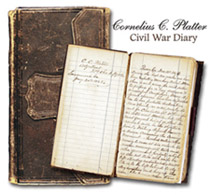 Lieutenant Cornelius C. Platter’s diary (Nov. 1864 – April 1865), which is available from the Digital Library of Georgia, provides an account of his service with the 81st Ohio Infantry Volunteers as they marched through Georgia and the Carolinas with General William T. Sherman. This diary offers an interesting perspective on life as an officer throughout this campaign. “We are entirely cut off from communication with the north and are an isolated command,” as Platter wrote on November 13, 1864. One can view the entire diary at once or select a specific section through the table of contents. The project also includes a collection of all the images from George Barnard’s Photographic Views of the Sherman Campaign (1866).
Lieutenant Cornelius C. Platter’s diary (Nov. 1864 – April 1865), which is available from the Digital Library of Georgia, provides an account of his service with the 81st Ohio Infantry Volunteers as they marched through Georgia and the Carolinas with General William T. Sherman. This diary offers an interesting perspective on life as an officer throughout this campaign. “We are entirely cut off from communication with the north and are an isolated command,” as Platter wrote on November 13, 1864. One can view the entire diary at once or select a specific section through the table of contents. The project also includes a collection of all the images from George Barnard’s Photographic Views of the Sherman Campaign (1866).
3
Feb
10
Help Improve the UGRR Digital Classroom
Posted by Matthew Pinsker Published in Antebellum (1840-1861), Images, Lesson Plans, Letters & Diaries Themes: Slavery & Abolition James McPherson writes in Battle Cry of Freedom (1989) that “On all issues but one, antebellum southerners stood for state’s rights and a weak federal government” (p. 78). Yet that one exception –the fugitive slave law– was a principal cause of the coming Civil War and potentially changes one’s view of the war’s meaning. White southerners were repeatedly infuriated by signs of northern resistance to the fugitive slave law. Abolitionists even taunted them by dubbing their efforts to help runaways an “Underground Railroad.” There was essentially a low-grade border war between North and South over this issue that lasted more than a decade and drove the conflict as much as the crisis over the western territories. Not everybody, not even McPherson, sees the impact of the Underground Railroad as looming this large during the antebellum period, but most of us at the House Divided Project do. That is why the first digital classroom we created was about the Underground Railroad. Partly funded by the NEH, this site offers a host of resources, including historic documents, images, interviews with leading scholars, Google Earth field trips, dozens of K-12 lesson plans and many more tools for the classroom. Especially since this is Black History Month, I hope readers of this blog post will use this opportunity to check out or reexamine these resources and post comments below offering feedback. Everything in the House Divided Project is still in what we are calling a draft edition –all can be fixed, improved or changed as we move toward a public launch during the Civil War 150th commemoration (2011-15).
James McPherson writes in Battle Cry of Freedom (1989) that “On all issues but one, antebellum southerners stood for state’s rights and a weak federal government” (p. 78). Yet that one exception –the fugitive slave law– was a principal cause of the coming Civil War and potentially changes one’s view of the war’s meaning. White southerners were repeatedly infuriated by signs of northern resistance to the fugitive slave law. Abolitionists even taunted them by dubbing their efforts to help runaways an “Underground Railroad.” There was essentially a low-grade border war between North and South over this issue that lasted more than a decade and drove the conflict as much as the crisis over the western territories. Not everybody, not even McPherson, sees the impact of the Underground Railroad as looming this large during the antebellum period, but most of us at the House Divided Project do. That is why the first digital classroom we created was about the Underground Railroad. Partly funded by the NEH, this site offers a host of resources, including historic documents, images, interviews with leading scholars, Google Earth field trips, dozens of K-12 lesson plans and many more tools for the classroom. Especially since this is Black History Month, I hope readers of this blog post will use this opportunity to check out or reexamine these resources and post comments below offering feedback. Everything in the House Divided Project is still in what we are calling a draft edition –all can be fixed, improved or changed as we move toward a public launch during the Civil War 150th commemoration (2011-15).
3
Feb
10
Westbrook Seminary: Educating Women
Posted by sailerd Published in 19th Century (1840-1880), Images, Letters & Diaries Themes: Education & Culture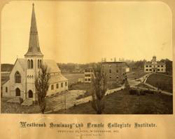 “Westbrook Seminary: Educating Women” is an interesting digital exhibit available through Maine Memory Network, which is managed by the Maine Historical Society. One can read a student’s diary (1843-1844) as well as learn more about several students who attended Westbrook Seminary throughout the 19th century. Check out all of the digital exhibits on Maine Memory Network here (including “Debates Over Suffrage,” “Hannibal Hamlin of Paris Hill,” and “Irish Immigrants in Nineteenth Century Maine” )
“Westbrook Seminary: Educating Women” is an interesting digital exhibit available through Maine Memory Network, which is managed by the Maine Historical Society. One can read a student’s diary (1843-1844) as well as learn more about several students who attended Westbrook Seminary throughout the 19th century. Check out all of the digital exhibits on Maine Memory Network here (including “Debates Over Suffrage,” “Hannibal Hamlin of Paris Hill,” and “Irish Immigrants in Nineteenth Century Maine” )
